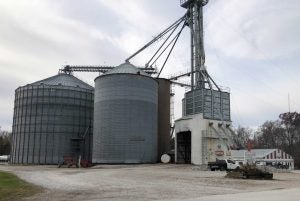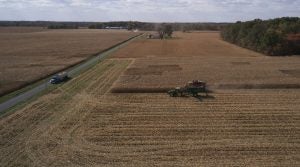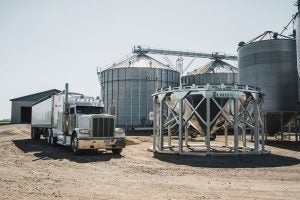The 2021 season may well be remembered as one where irony was the top crop harvested. With crop production and prices at levels that should have had folks excited and optimistic, many in the field are still weeding through problems great and small related to the COVID-19 pandemic. And it never helps when a local grain elevator announces its intent to stop receiving grain.
In August, Ceres Solutions Cooperative Inc. announced to its members and customers in Clay County, Indiana, its intent to cease receiving grain effective December 31 at its Brazil and Clay City locations.
Clay County farmer and insurance agent Scot Rubeck said for him and a number of his neighbors, this will be the last growing season, and the lack of access to local grain elevators going forward is a major factor in that decision.
“I’ve heard more small farmers say they’re not going to continue farming after this year than any other in my 15 years in the ag business,” Rubeck said.

Shane Litz, vice-president and commercial loan officer at Terre Haute Savings Bank, said the local elevator’s decision to close its grain business will impact farmers throughout the region. But this is just one more problem in what’s been a complicated season across the world. Going forward, he said more troubles could still be at hand for producers — not just in Clay County, but across the country — as the cost of inputs are projected to increase for 2022 and perhaps 2023, with no guarantee that crop prices will match these costs.
In September this year, the Ag Economy Barometer, a nationwide monthly survey of producers, reported a drop of 14 points to a reading of 124, the weakest sentiment of farmers since July 2020 when it hit 118 amid the first big wave of COVID-19 quarantine measures.
Smaller producers like Rubeck simply say it’s time to get out, as the added cost of transport to another grain elevator being the last straw.
Boatloads of bottlenecks
With a record demand for Chinese grain due to global weather issues and the COVID-19 quarantine, compounded by international supply chain snarls, corn prices per bushel were $5.77 at November’s end with soybeans at $12.64. And American producers responded in kind this year, with both corn and bean production up 3 percent and 5 percent, respectively, from 2020. Corn production for 2021 is forecast to exceed 15 billion bushels, with beans at 4.45 billion, and average yields of 176.5 and 51.5 bushels per acre, respectively.
Unfortunately, input costs rose dramatically this year, too, as inflation soaked the economy. Grain storage was going to be tight, and many producers around the country were already investing in their own grain bins. And then in August, farmers in west central Indiana learned that news that one of the state’s leading cooperatives was going to cease accepting grain at two locations.
In a letter sent to Clay City and Brazil grain customers by Ceres Solutions Cooperative CEO Jeffrey Troike dated August 12, producers were informed that:
“It has been determined that, due to the age and condition of our grain facilities, and also due to declining utilization, Ceres Solutions will no longer receive grain at the Clay City and Brazil locations as of December 31, 2021. The exception to this date is to serve those customers who have a delivery contract in place. We regret any inconvenience this decision may cause. Unfortunately, both locations require significant investments to maintain proper services, and there is simply not enough volume for us to be able to support that decision.”
Both locations will continue to service the communities by way of their agronomy sales. But whereas once upon a time, Clay County had boasted multiple grain elevators, by this year the Brazil and Clay City locations were really the last of their kind in a county with a population of about 26,000.

Ceres Solutions does offer grain services in partnership with Gavilon Grain in Clay County’s next-door neighbor Vigo Terre Haute, 22 miles from Brazil. Another elevator offers this service at Shelburne in Sullivan County, which is about 22 miles from Clay City. But for producers in eastern Clay, Parke, and Owen counties, the mileage is perhaps double and not always easily traveled. Litz said many of his larger customers are building additional storage operations on their own farms, and this could certainly bring risk depending on the future costs of inputs and market prices.
The additional cost associated with that drive is just one too many, Rubeck said.
“That’s the main reason I’m renting out my ground and quitting,” said Rubeck, owner of 300 acres. A partner in Allied Insurance Agency and broker of crop and farm insurance by day, Rubeck has been a lifelong producer as well as an auctioneer with 15 years in ag. But with a recent farm-related injury, young children at home, and a successful farm insurance brokerage to run, the added prospect of hauling his grain nearly 40 miles instead of 10 was just too much. Too much for he and four surrounding neighbors he named right off the top of his head, each of whom farm in the 200- to 300-acre range.
“Do I think guys are getting out because the elevators are shutting down? Absolutely,” he said.
Laurel Mann, corporate spokeswoman for Ceres Solutions Cooperative, said she understands many members and customers are unhappy about the decision, but ultimately it’s in the best interest of the members.
Rubeck harbors no ill will toward the cooperative and said he’s always liked their employees. There’s no way to really blame them for making a business decision based on the numbers, but he feels matter-of-factly that irrespective of the reason, the end result here will be more consolidation and fewer small farmers.
“These are record times that we’re in front of,” he said, noting the yields and prices. “And people are still quitting due to the costs.”

Rubeck said he made it a point to arrange for his land to be farmed next year by another family farmer, who may be able to pick up more ground yet as a result of this move. The problem in ag, he said, is smaller producers continue to lose out and at some point, there might not be any at all.
The only good news he could see is that the decision to close might create an opportunity for a smaller organization to perhaps open an elevator service to fill the gap. But that simply hasn’t been typical of small town U.S.A. over the years, where the trend has been moving toward farmers building their own larger storage facilities.
Across the country, grain storage capacity has risen sharply in larger facilities, but this doesn’t help the smaller operators in more remote, rural areas.
“This will affect every farmer in Clay County,” he said, pointing out that such concentration leads to longer lines of trucks at fewer elevators farther apart. With the Brazil and Clay City facilities holding roughly 700,000 bushels of grain between them, that load will now be bottle-necking the line somewhere else, he said.
Concerns growing forward
Litz said he’s been having conversations with his ag clients since the announcement was made. Most of the farmers in the 1,500- to 1,800-acre category already truck greater distances depending on prices. That said, a local elevator is always good to have around for the larger farmers who rent smaller fields in remote areas. Meanwhile, the smaller farmers will be facing a much costlier barrier, and what elevators do wind up receiving the grain will see their own costs rise due to longer lines.
“It’s already bottle-necked a little as it is,” he said, noting this is why many of the bigger outfits simply haul their own grain greater distances, some all the way down to the barges near Evansville.

The decision to invest in more grain storage units on their own farms is a weighty one.
“I’m hearing a lot of that and I’m seeing it,” Litz said. But with the spike in fertilizer prices this year and the increased certainty of higher costs next year, the prospect of a big capital expenditure on the grounds could be risky. And while interest rates for ag-lending are favorable right now, a sudden drop in crop prices could leave even the bigger farmers in the lurch.
“I think it is a good time to borrow rate-wise, with some precautions. Inputs are going to be significantly higher next year. There’s no doubt. I don’t feel really good about 2022,” Litz said. This is particularly problematic for farmers who cash-rent their ground for a fixed price. The local break-even for corn this year was between $4 and $4.75 per bushel, with $10 to $11 for soybeans, depending on size variables, he said. And as all producers know, those figures don’t include labor or other soft costs.
Given all that, it’s increasingly problematic for producers under about 1,500 acres to handle the increased costs associated with trucking grain an extra 20 to 40 miles, let alone finance extensive capital improvements such as bins on their own farm, he said.
Brian Boyce is an award-winning writer living on a farm in west-central Indiana. You can see more of his work at http://www.boycegroupinc.com/.



